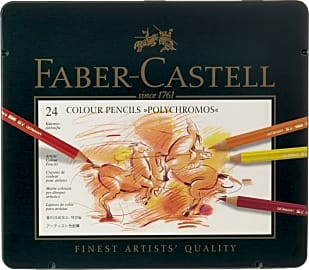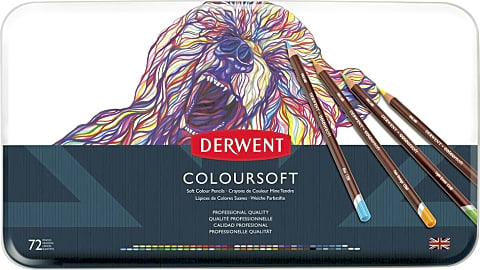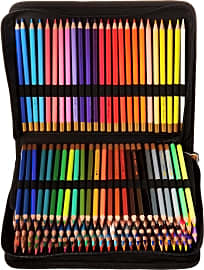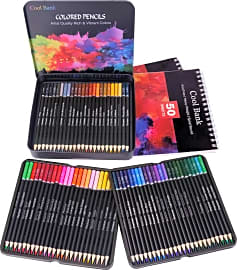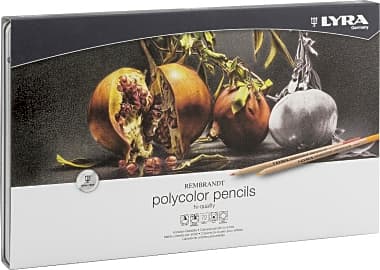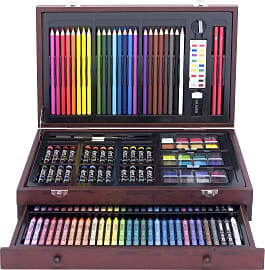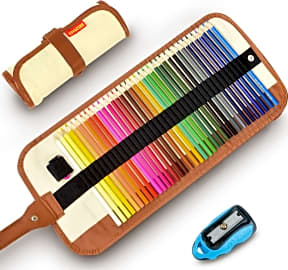The 10 Best Colored Pencil Sets

This wiki has been updated 36 times since it was first published in January of 2016. Whether you're looking for a fun pastime for your kids or are a serious artist or art student needing supplies, one of these colored pencil sets should suit you nicely. We've included both affordable and professional-quality options, as well as wax- and oil-based versions. You can use these to craft your latest masterpiece or to simply de-stress with an engaging coloring book. When users buy our independently chosen editorial recommendations, we may earn commissions to help fund the Wiki.
Editor's Notes
October 28, 2020:
We removed the Imaginesty IM due to availability concerns and replaced it with the Cool Bank Professional. The Cool Bank Professional is at a similar price point, but has more shades and even includes two drawing pads. We also replaced the Castle Art Supplies Premium set with the Covacure Premier. We wanted to include another budget-friendly option and add some variety to the types of carrying cases. The Covacure Premier comes in a canvas roll that you can easily travel with and keep organized. The Faber-Castell Polychromos 120, Prismacolor Premier, and Caran d'Ache Luminance remain high in the ranking because of their soft, blendable lead and vibrant pigments. However, they are best if you’re a more experienced artist and feel a pricey colored pencil is best for you.
June 02, 2019:
Colored pencils aren't just for kids, and the many artist-quality sets on this list prove that. If you are particular about your art supplies and take your drawing seriously, there are few better options than the Faber-Castell Polychromos and Caran d'Ache Luminance. On this list we included both the Faber-Castell Polychromos 120 and the Faber-Castell Polychromos 24, so whether you need a complete set or simply a few new colors to round out your collection, there is a professional-level option here. The Faber-Castell Polychromos are oil based, whereas the Caran d'Ache Luminance are wax based. They both produce deep and vibrant colors, but the wax-based Caran d'Ache Luminance are much easier to erase, so if you make a lot of mistakes, they will probably be a better choice. On the other hand, the Faber-Castell Polychromos definitely layer a bit better. While not quite up to the same quality, though truly not that far behind either, the Prismacolor Premier are near-artist grade, yet cost considerably less. If you like pencils with a little more heft and hard leads, you'll enjoy the thick barrels of the Derwent Coloursoft, whereas the lesser-quality Imaginesty IM are relatively lightweight. The Thornton's Art Supply 01504 made the list because of the exceptional value it offers, as did the Art 101 53142, and they are ideal for beginners, though most experienced artists probably won't be happy with these brands.
Special Honors
Blick Studio Artists' Colored Pencils The Blick Studio Artists’ Colored Pencils offer versatility with their wide range of sets and shades. The lead is professional quality, having been developed with feedback from the Colored Pencil Society of America. They are available in various assorted sets, but they are also available in more specific color ranges, such as greys and landscape. You can even buy them individually if you are looking to supplement your collection. dickblick.com
The Myriad Advantages of Working With a Colored Pencil Set
Colored pencils are self-sufficient, in that an artist doesn't need anything more than a canvas or a page in order to get to work.
Colored pencils have only been around for a fraction of the time that paint and artist's charcoal have - a fact which might explain why colored pencils are often afforded such short shrift. This is unfortunate, especially considering that colored pencils can offer an entire litany of advantages, even if an artist is only using this medium to create an early mock-up of his work.
Consider, as an example, that the point of a colored pencil allows for greater precision than almost any other handheld implement. Colored pencils also feature UV-resistant pigment, meaning that while a sheet of paper may fade due to sunlight, the pigment that is left there by a colored pencil will not.
Working in colored pencil means that there's no need for any prep work or clean-up. Colored pencils are self-sufficient, in that an artist doesn't need anything more than a canvas or a page in order to get to work. What's more, these pencils take up little space, and they don't produce fumes, like certain paints, or a marker can.
Artist-grade colored pencil sets can feature up to 120 shades, displayed in a consecutive array like swatches. These sets are sold in cases, rendering them entirely portable, and they're ideal for taking with you on a road trip, or for sketching freehand in the park.
How to Care for & Preserve Your Colored Pencils
Most people who own a colored-pencil set have their favorite colors, which they consistently use without a lot of forethought. While this may be convenient, it doesn't bode well for maintaining a complete set of pencils, long-term. For in the end you wind up with 90% of your pencils completely unused, while the other 10% have been worn down to a nub.
Most people who own a colored-pencil set have their favorite colors, which they consistently use without a lot of forethought.
The first way to avoid this is by designating secondary colors for everyday use. If you're accustomed to using a primary red, for example, then perhaps you should switch to a shade of red that you wouldn't otherwise try. This way you can preserve most of your primary colors, while getting use out of some of your secondary colors at the same time.
Much like a crayon that picks up resin from another color's wax, tracing over one shade of wax- or oil-based color pencil can tarnish the color and quality of another. That being the case, you'll want to be sure and wipe down the tips of any pencils that have been used to blend colors or fine-tune a shade. You'll also want to invest in a kneaded eraser, which you can use whenever "knead" be.
Ideally, you'll want to use a utility knife to sharpen the point of any colored pencils. Mechanical and electrical sharpeners tend to shave off a lot of unnecessary wood. On top of which, wax-based pencils can cause a pencil sharpener to jam. Utility knives, when used correctly, are not only efficient, but they'll provide your pencils with a much finer point, as well.
How The Colored Pencil Came To Be
The word pencil, meaning little tail, was initially used to refer to the bristles of an artist's brush. That began to change, however, during the 16th Century, after British prospectors discovered graphite while excavating a series of mines beneath Grey Knotts.
The British Government immediately seized these mines, intent on using graphite as a resource for building armaments. Civilian use of graphite was strictly prohibited, a fact which did not stop British artists from breaking in and stripping the mines. These bandits soon found that there was an issue with using graphite for artistic purposes in that the composition was soft, and it would often break if grasped too hard.
And during the 1800s, several entrepreneurs began refining powdered graphite into a hardened form.
That problem was solved by an Italian couple in 1560. Inspired by draftsmen who had taken to wrapping graphite between sheepskin, this couple experimented with encasing graphite inside an oval piece of wood. The result gave birth to what affectionately became known as the graphite pencil - an industry that England lorded over as a result of owning the only supply.
As it turned out, powdered graphite was abundant across any number of continents. And during the 1800s, several entrepreneurs began refining powdered graphite into a hardened form. One of these entrepreneurs, an American named Joseph Dixon, came up with a process for mass producing graphite pencils at a meager cost. Dixon died in 1869, but the company that he founded, Dixon Ticonderoga, was already on the verge of becoming the largest pencil manufacturer in the world.
Given the viability of wooden pencils, it wasn't long before manufacturers began to use wax, as opposed to graphite, for developing colored pencils, as well. The first colored pencils were introduced by a German company named Faber-Castell in 1908. Despite some initial success, the watershed moment for colored pencils didn't occur until 30 years later, when a company named Prismacolor came to market with a line of pencils that transformed the concept from passing novelty to artist prestige.
Today, colored pencils remain popular. These pencils are largely sold to artists, fashion designers, graphic designers, and advertisers, but they are also marketed to college students, along with families with young kids.




